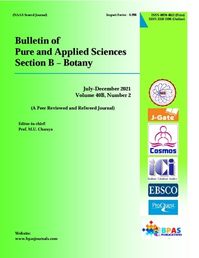Checklist and Conservation of Spices’ Plant Species in Ijesa Region of Osun State, Nigeria
DOI:
https://doi.org/10.48165/Keywords:
Conservation, spices, Annihilative, Ijesa regionAbstract
The spices’ plant species in Ijesa region of Osun State, Nigeria were examined in this study through field observation and interviews with randomly selected respondents using a semi-structured questionnaire matrix. The interviews were focused, conversational and two-way in communication. Spices plant species used and the part(s) of the species used were indentified. The cultivation status of the identified spices’ plant species was defined. Group interviews were conducted in each community to validate the information obtained during the individual interviews. Also the abundance status of the spices’ plant species in each community was determined. A total of 29 spices’ plant species, belonging to 18 families were identified in the region. Thus the identified spices were derived from diverse plant species; most of them were aromatic and pungent and contained various active ingredients. The flower/fruits/seeds formed the major parts used and their extractive methods used were destructive and annihilative. 45% of the identified species were not cultivated but occurred in the wild where a number of anthropogenic activities affect their demography. 28% of these species were rare and they were mostly indigenous tree species that were not cultivated in the study area. Strategies that could ensure sustainable supply of the spices plant species were recommended.
Downloads
References
. Achinewu, S.C., Aniena, M.I. and Obomanu, F.G. (1995). Studies on spices of food value in the South eastern states of Nigeria 1: Antioxidants Properties. J. African Med. Plants 18,135- 139.
. Adedeji, D. E., Kayode, J. and Ayeni, M.J. (2018). An Ethnobotanical Study of Plant Species Used for Medicine by the Eegun Indigenous Tribal Group of Lagos State, Nigeria. Not. Sci. Biol. 10(3), 318-327.
. Anon. (2019). Spices and condiments. http://ecoursesonline.iasri.res.in/ mod/page/view.php?id=105639 Assessed July 28, 2019.
. Ayoola GA, Folawewo AD, Adesegun SA, Abioro OO, Adepoju BA, Coker HA (2008). Phytochemical and antioxidant screening of some plants of Apocynaceae from south west Nigeria. African Journal of Plant Science 2(10), 24-128.
. Cunningham, A. B. (1988). Collection of wild plant food in Tembe Thonga Society: A guide to Iran age gathering activities? Annals of the Natal Museum 29(2), 433-446. [6]. Dziezak, J.D. (1989). Innovative food trends: Species. Food Technology 43(1), 102-116. [7]. Ekanem, A. P. and Udoh, F. V. (2009). The diversity of medicinal plants in Nigeria: An overview. African Natural Products: New Discoveries and Challenges in Chemistry and Quality, ACS Symposium series. American Chemical Society 1021:135-137.
. Fasola, T. R. and Egunyomi, A. (2002). Bark extractivism and uses of some medicinal plants. Nigerian Journal of Botany 15, 26-30.
. Iwu, M.M. (1993) Handbook of African Medicinal Plants. Boca Raton, CKC Press 435 pp.
. Johns, A. D. (1988). Effects of ‘selective’ timber extraction on rainforest structure and composition and some consequencies for frugivores and folivores. Biotropica 20, 31-37. [11]. Kayode, J. (2004). Conservation Perception of Endangered Tree Species by Rural Dwellers of Ekiti State, Nigeria. Journal of Sustainable Forestry 19(4), 1-9.
. Kayode, J. (2008). Survey of Plant Barks Used In Native Pharmaceutical Extraction in Yorubaland of Nigeria. Research Journal of Botany. 3(1), 17-22.
. Kayode, J. and Ogunleye, T. (2008). Checklist and Status of Plant Species Used as Spices in Kaduna State of Nigeria. Research Journal of Botany, 3 (1), 35-40.
. Kayode, J., Aleshinloye, L and Ige, O. E. (2008). Ethnomedicinal use of Plant Species in Ijesa land of Osun State, Nigeria. Ehnobotanical leaflets 12, 164-170.
. Kayode, J. and Omotoyinbo, M. A. (2009). Ethnobotanical utilization and conservation of chewing sticks plant species in Ekiti State, Nigeria. Research Journal of Botany 4(1):1-9. [16]. Kayode, J., Arilewo, K and Ayeni, M. J. (2016). Potentials of Myths In Ijesa Indigenous Community of Nigeria in the Conservation of her Forest. Bangladesh J. Bot. 45 (5), 1151- 1156.
. Macmillan, H.F. (1984). A Handbook for Tropical Planting and Gardening. Macnidlan Scientific Publishers, London. 326 pp.
. Osabor VN, Etiuma RA, Ntinya MU (2016). Chemical profile of leaves and roots of miracle fruit (Synsepalum dulcificum). American Chemical Science Journal 12(1), 1-8. [19]. Oni O. G. and Kayode, J. (2018). Ethno-medicinal assessment of wild edible plants in Ijesa region, Osun State, Nigeria. Bulletin of Pure and Applied Sciences 37 B (2), 89-107. [20]. Peters, C. M. (1996). Observations on the sustainable exploitation of non-timber tropical forest products: An ecologist’s perspective. Pp. 19-41. In Ruiz-Perez, M. and Arnold,J. E. M. (Eds. ). Current issues in non-timber forest products research. CIFOR-ODA, Rogor Camp Workshop.
. Schippers, R. R. (2000). African indigenous vegetables: An overview of cultivated species. Natural Resources Institute/ACP-EU Technical Centre for Agricultural and Rural Cooperation, Chatham, UK, 214pp.
. Shinwari, M. I. and Khan, M. A. (2000). Folk use of medicinal herbs of Magalla Hills, National Park, Islamabad. Journal of Ethnopharmacology, 69, 45-56.
. Soladoye, M. O. and Sonibare, M. A. (2003). Non-timber forest products of Old Oyo National Park and their sustainability. Nigerian Journal of Botany 16, 16-32.




